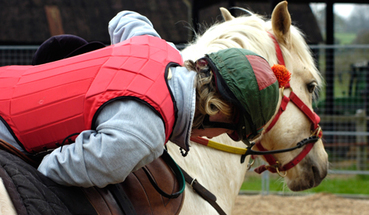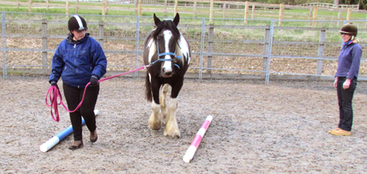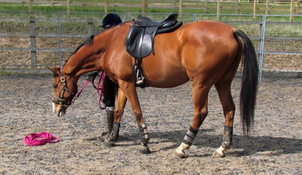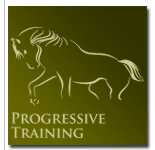Train Equus - Progressive Training
This can be something as simple as asking a horse to stand for mounting or to be attentive when led, to the re-introduction of a rider onto a former bucking horse. Progressive Training can be tailored as one to one session(s) with Lynn at either her facility or your own, or via the various Train Equus Day or Weekend Clinics Lynn runs from her Twyford yard. Meanwhile, here is a summary of how we apply our positive training methods to help our clients and their horses.
Ridden Work

How we approach this is as varied as the horses we are handling. With a true starter we simply begin with legging up a rider to bridge over the saddle. For restarters or a remedial problem associated with a rider we can use a flag devise, perhaps a set of false legs and in extreme cases even a dummy rider as a step between a flag and a real rider.
Most horses are fitted with and ridden bitted, others if specifically requested are trained bitless. How we ride adapts: softening out of the saddle to encourage a retraining horse to begin re-learning how to round its back; riding with a light contact to encourage a reluctant horse to come to our hands again, sitting quietly whilst acccurately placing the feet of a young horse to make its job of balancing and responding correctly much easier. It’s all about letting a horse know you are trying your best for them and they will respond similarly if they are able. The trick is not asking for answers before a horse can listen and understand which response is appropriate. Setting up a horse and rider to succeed is what we do. The little successes may seem so small to someone watching but these are what build the foundations for bigger successes later. From asking a spooky horse to face a small folded tarpaulin calmly as a very important first step or a difficult loader to simply focus on you the handler at the bottom of the ramp, to asking the frightened horse to lower its head and accept a head rub.
Most horses are fitted with and ridden bitted, others if specifically requested are trained bitless. How we ride adapts: softening out of the saddle to encourage a retraining horse to begin re-learning how to round its back; riding with a light contact to encourage a reluctant horse to come to our hands again, sitting quietly whilst acccurately placing the feet of a young horse to make its job of balancing and responding correctly much easier. It’s all about letting a horse know you are trying your best for them and they will respond similarly if they are able. The trick is not asking for answers before a horse can listen and understand which response is appropriate. Setting up a horse and rider to succeed is what we do. The little successes may seem so small to someone watching but these are what build the foundations for bigger successes later. From asking a spooky horse to face a small folded tarpaulin calmly as a very important first step or a difficult loader to simply focus on you the handler at the bottom of the ramp, to asking the frightened horse to lower its head and accept a head rub.









